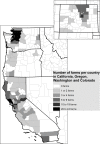Small-scale and backyard livestock owners needs assessment in the western United States
- PMID: 30763403
- PMCID: PMC6375643
- DOI: 10.1371/journal.pone.0212372
Small-scale and backyard livestock owners needs assessment in the western United States
Abstract
The number of small-scale and backyard livestock and poultry owners in urban and peri-urban areas has increased greatly over the last 10 years in the U.S. However, these animal owners may live in areas without access to livestock and/or poultry veterinary care. The purpose of this study was to identify potential veterinary service needs of these animal owners in the western US, assess their use of management and husbandry practices with regards to disease prevention, and assess their attitudes about animal health and food safety. A semi-structured survey was made available to small-scale and backyard livestock and poultry owners in Washington State, California, Colorado and Oregon. The survey instrument included questions about types of animals reared, uses of the animals, veterinary services and information-seeking behaviors of owners, attitudes on animal health and food safety, and management practices. Four hundred thirty-five individuals completed at least some portion of the survey. Most described themselves as living in rural areas (76%). Most (86%) owned chickens, 53% owned small ruminants, and 31% owned cattle. Many individuals owned more than one species and most had fewer than 20 animals of a given species. About 74% of respondents utilized their animals' products for their own consumption but 48% sold animal products (primarily through internet sales (35%) or farmers' markets (25%)). Overwhelmingly, respondents gained information about animal health (82%) and animal treatment procedures (71%) from the internet. Respondents reported their veterinarian's practice type as companion animal (26%) or a mixed animal or food animal predominant (66%). Overall, respondents were very satisfied with the level of care (82%), but 43% had not sought animal health care in last 12 months. However, the veterinarian's primary practice type and owner's satisfaction with veterinary care were associated with their location (state), species owned, and urban or peri-urban setting. Livestock species type (cattle, small ruminants and swine), and use (personal or commercial) were associated with implementation of different biosecurity practices. The results of this survey highlight some of the needs of these animal owners for veterinary care and information which are location- and species-specific. Veterinary care for these small-scale and backyard animals is vital to the health and welfare of the animals as well as for identification of zoonoses and assurance of the food safety of animal products.
Conflict of interest statement
The authors have declared that no competing interests exist.
Figures






Similar articles
-
Assessment of veterinarians' engagement with backyard poultry and small-scale livestock operations in four western states.J Am Vet Med Assoc. 2020 Jul 15;257(2):196-209. doi: 10.2460/javma.257.2.196. J Am Vet Med Assoc. 2020. PMID: 32597725
-
Assessment of the knowledge and behavior of backyard and small-scale producers in California regarding disease prevention, biosecurity practices and antibiotics use.PLoS One. 2022 Nov 21;17(11):e0277897. doi: 10.1371/journal.pone.0277897. eCollection 2022. PLoS One. 2022. PMID: 36409736 Free PMC article.
-
Backyard chickens in the United States: a survey of flock owners.Poult Sci. 2014 Nov;93(11):2920-31. doi: 10.3382/ps.2014-04154. Epub 2014 Sep 5. Poult Sci. 2014. PMID: 25193256
-
Backyard poultry: exploring non-intensive production systems.Poult Sci. 2024 Feb;103(2):103284. doi: 10.1016/j.psj.2023.103284. Epub 2023 Nov 17. Poult Sci. 2024. PMID: 38056053 Free PMC article. Review.
-
A scoping review of studies reporting biosecurity practices in small and backyard farms raising livestock or poultry in developed countries, 2000-2022.Prev Vet Med. 2025 Mar;236:106423. doi: 10.1016/j.prevetmed.2025.106423. Epub 2025 Jan 11. Prev Vet Med. 2025. PMID: 39824150
Cited by
-
Backyard poultry cases in UK small animal practices: Demographics, health conditions and pharmaceutical prescriptions.Vet Rec. 2021 Apr;188(7):e71. doi: 10.1002/vetr.71. Epub 2021 Jan 28. Vet Rec. 2021. PMID: 33835557 Free PMC article.
-
Risk factors for hospitalization among adults aged ≥65 years with non-typhoidal Salmonella infection linked to backyard poultry contact.Zoonoses Public Health. 2022 May;69(3):215-223. doi: 10.1111/zph.12911. Epub 2022 Jan 21. Zoonoses Public Health. 2022. PMID: 35060679 Free PMC article.
-
Genetic Diversity of Bovine Pestiviruses Detected in Backyard Cattle Farms Between 2014 and 2019 in Henan Province, China.Front Vet Sci. 2020 Apr 17;7:197. doi: 10.3389/fvets.2020.00197. eCollection 2020. Front Vet Sci. 2020. PMID: 32363203 Free PMC article.
-
Genetic and Environmental Factors Contributing to the Pathogenesis of Vertebral Osteomyelitis Caused by Enterococcus cecorum in Broiler Chicken.Animals (Basel). 2025 Aug 8;15(16):2327. doi: 10.3390/ani15162327. Animals (Basel). 2025. PMID: 40867656 Free PMC article. Review.
-
Risk Factors for Positivity to Shiga Toxin-Producing Escherichia coli and Salmonella enterica in Backyard Production Systems Animals from Metropolitana Region, Chile: A Threat to Public Health?Int J Environ Res Public Health. 2021 Oct 13;18(20):10730. doi: 10.3390/ijerph182010730. Int J Environ Res Public Health. 2021. PMID: 34682504 Free PMC article.
References
-
- Surls R, Feenstra G, Golden S, Galt R, Hardesty S, Napawan C, et al. Gearing up to support urban farming in California: Preliminary results of a needs assessment. Renewable Agriculture and Food Systems. 2014; FirstView:1–10. 10.1017/S1742170514000052 - DOI
Publication types
MeSH terms
LinkOut - more resources
Full Text Sources

